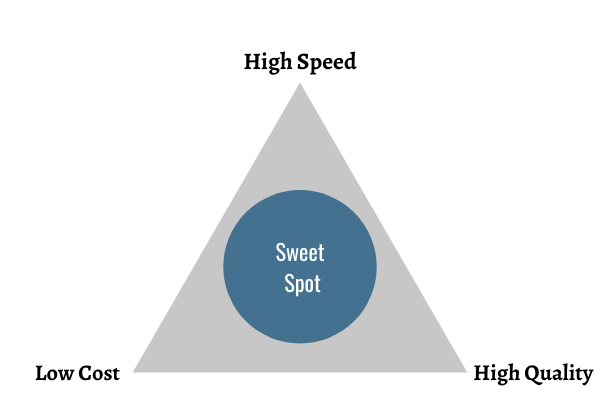When it comes to construction, the top three concerns on the mind of every building owner and developer are cost, quality, and speed.
Everyone wants their project to be of the highest quality at the lowest cost, and for it to be done in as little time as possible. It is why we have built Peak Development Partners on the promise of delivering your finished product “on time, on budget, or better.”
There is an old adage: “Good, fast, cheap… pick two.” We find this to be an oversimplification, but there is some truth to it. Very often on a project, cost, quality, and speed do compete with one another, based on your priorities.
This graphic illustrates the competing nature of cost, quality, and speed:

As you move towards any one tip of the triangle, you are logically moving away from the other two. So, If you decide to focus more on shortening your schedule (speed), you will often have to sacrifice quality, and will almost certainly increase your overall cost. If your aim is to reduce cost, quality tends to suffer, and it will likely take you longer to finish.
Managing cost, quality, and speed is a balancing act that every owner and developer has to contend with. We have found that the solution always comes down to a simple consideration: what are the goals of the ownership and development team?
A clear understanding of those goals is crucial to minimizing how much you will have to sacrifice certain points of the cost, quality, speed triangle in favor of others.
In this article, we will focus on how owners and developers that are most concerned with shortening their schedule can mitigate the effect on quality and cost.
Speed/Schedule
What does it mean to be “on time”?
Some projects aren’t impacted by the timing of their opening, while others are. For example, in the hospitality industry, most hoteliers want to open in the Spring, because that is the start of the tourist season, and they want to capitalize on that.
So, starting in the winter or fall is not optimal because then you would have to go through the winter to get opened on time.
Again, another example of how understanding the owner/developer’s goals is of crucial importance.
Speed is the trickiest point on the triangle because, unlike cost or quality, you can almost never “gain” time. And, once you have lost time, it is usually gone forever.
I wish there was a more scientific explanation for why this is, but it really comes down to one fact: things take as long as they take.
Paint takes a certain amount of time to dry, as does drywall. Cement takes a certain amount of time to set and harden. These things are known and, more importantly, they’re constant.
Things being constant seems like it would be a valuable asset in construction. And, for the most part, it is.
Where it can work against you is when issues pop up that threaten your construction schedule. You won’t have the option of making up the lost time by accomplishing other tasks more quickly.
When you try to increase speed to make up for lost schedule time, it can come at the expense of quality. Corners are cut, mistakes get made and, ultimately, craftsmanship tends to take a backseat to merely “checking the box.” It’s not that quality is intentionally overlooked, it’s that when speed is demanded, quality often suffers. Speed and quality are two masters that are hard to serve at the same time.
So, a drywall finish may not be as smooth as it can be, which shows up even more when the surface gets painted. Or perhaps your frame isn’t straight and now your flooring is being laid on an uneven surface.
Not to mention the possible safety ramifications that come with rushing. Taking shortcuts inevitably means work gets sloppy. And sloppy work almost certainly leads to workplace accidents.
The best thing you can do to “gain” speed is to protect yourself from losing it in the first place.
The way that you do that is found in the tenets of Do-it-together development:
- Build your team early
- Leverage your team’s talents
- Protect your time
- Manage your project proactively
When you build your team early and can get many sets of eyes reviewing all of the different things that have to happen with your project, you can uncover potential risk areas, and address them, much earlier.
With a team in place that has a full understanding of the project from the onset, you can also employ one of the most effective tactics in DIT development: running concurrent processes during the pre-construction phase.
For example, when getting your application to the planning board, there will almost always be a set of comments/notes that come back that need to be addressed before you can proceed. The design team and ownership need to understand what those requested changes are, how they will impact all three points of the cost/quality/schedule triangle, and have time to implement those changes, and then resubmit the application for approval from the planning board.
In the meantime, you could be working on other things, like utility applications. Those need to be submitted as early as possible, so that you can manage and coordinate multiple utilities and how they impact your site.
Running processes concurrently as early and often as possible in the pre-construction phase is perhaps the only way your schedule can actually “gain” some speed. And this makes it an essential component to the “speed” point of the triangle.
Other ways you can mitigate the loss of speed is by working 2-3 shifts, taking advantage of premium time (overnights, weekends, etc.), adapting to working through winter conditions, etc. However, keep in mind that any of these will certainly impact the overall cost of the project.
Again, it all comes back to understanding what the owners/developers are trying to accomplish, and dialing in the opening time for the specific project you’re working on so that you can finish on time, on budget, or better.
This is the second in a three-part series of posts on the cost/quality/speed triangle. Stay tuned for the final installment as we spotlight on how quality can affect cost and speed.

